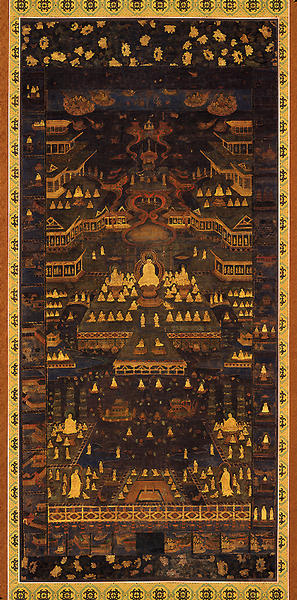Pure Land Mandala
- Kamakura period
- 14c
- Hanging scroll, color on silk
- H-89.8 W-41.3
Catalogue Entry
Kamakura period, 14th century
Hanging scroll, color on silk
Height, 89.8cm; width, 41.3cm
Mandala images depicting the pure land paradises of the various Buddhas are, in general, called Pure Land Mandalas. Here, however, the central section depicts the Pure Land Paradise of the West of Amida Nyorai (Amitabha), while the tale of Idaike (Vaidehi) (to the left from the viewer's position), the 13 aspects to evoke thoughts of Paradise (right), and the kubon-ojo categories of the people who attain rebirth in Paradise (lower section) are shown around this central Paradise scene. The Kanmuryoju sutra (Amitayur-buddha-dhyana-sutra) and its commentary, Sha∀n Dao's (Zen Do) Kangyo Shijo-no-sho, form the basis for this set of images, and this iconography is called a "Kangyo Henso" image. The Taima Mandala is the iconographic basis for this subject in Japan, and as a result these images are frequently called Taima Mandalas.
This iconography is thought to have been generally disseminated when Shoku of the Seizanha branch of the Jodo sect copied the original image in Taimadera, Nara, in 1237 (Katei 3), and when a number of reduced-size versions of the image were made. These images were then spread throughout Japan. By the time Shoku made his copy, the kubon-ojo scene and the inscription in the center of the lower edge had already become hard to decipher due to ground silk losses. It is thought that originally a raigo group of figures arranged in seated positions was part of the ojo section, but in the Shoku lineage iconography, these figures have been changed to the standing forms of the deities, the popular style at the time.
The present work is an example of these Shoku lineage Taima Mandalas. Its extremely tall and narrow format is unusual in this group, and yet none of the important scenes from the original image have been omitted, including the Fushi- sogoe scene at the bottom edge of the central section (Amida is depicted as the father, the masses as the children, and the masses who have been reborn in Paradise face Amida). The painted mount of lotus and karakusa motifs at the top and bottom of the silk are also considered to be part of the original image. The various deities have bodies painted in gold paint with details picked out in cinnabar red lines. The drapery is shown with tan red grounds, and cut gold leaf motifs are used to decorate the draperies, including linked swastika motifs, hemp leaf motifs, and basket weave motifs. The sweet expressions of the deities are particularly impressive, and the work can be considered to have been painted in the latter half of the Kamakura period. TI
